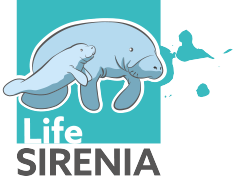Assessment
Throughout the project, the LIFE SIRENIA team will assess the project from several angles using various means. The team?s mission will be to establish a participatory network and to ensure the monitoring of animals by means of transmitters. Studies of the impact of the project on the natural environment and socio-economic activities will also be conducted.
The participatory network
![]()
Following the release of the manatees, a participatory network involving the users of the GCSM will be set up to monitor the animals in the natural environment. In the event of a problem (injury, disease, etc.), their care will be more all the more effective.
Documents will be communicated to the public. They will provide information concerning the reintroduction of the manatees and their occupation of the natural environment.
In order to better track the manatees, monitoring equipment will be fitted to each individual released. It will also be necessary to ensure the daily operation of the network while exploiting the recorded data and measurements.

Monitoring equipment :
This consists of two transmitters in a watertight floater connected to the manatee by a tether. The latter is fixed to a belt placed on the peduncle (the junction between the body and the tail) of the animal. These transmitters will supply usable data concerning the movement of the animals and will enable the definition of areas of research.
Operation of the network:
Once the manatees are released, a National Park team will monitor the animals. They will relay each other land and at sea so as to provide regular monitoring and usable data.
The data collected will provide us with better knowledge of the manatee and its behaviour.
Observation forms to be filled in will be given to as many users of Grand Cul-de-Sac Marin as possible.
Should a manatee escape or lose its transmitters, all of the territorial stakeholders and the population of Guadeloupe will be kept informed until it is relocated. The same will apply to the territories surrounding Guadeloupe.

Assessment of ecosystem impact
![]()
A study to identify the uses of the environment (feeding, resting, reproduction, etc.) by the reintroduced manatees will be conducted and will bring to light the potential conflicts of use with the users of the bay. If potential or proven zones of conflict are identified, proposals for management can be proposed within the framework of this same study.
A second study will be conducted to measure the impact of the manatee on the seagrass beds and the micro-fauna they shelter.
Finally, the team in charge of the project will verify whether the presence of manatees in the bay of Grand Cul-de-Sac Marin leads to an increase of tourism for the site and whether the authorities have taken into account the threats at the community level (pollution, water quality, upgrading sewage treatment plants to standards). In addition, it will assess whether this reintroduction has led to the increase of actions for protection and conservation in the bay.
Assessment of the socio-economic impact
![]()
At the end of the project, an assessment of the benefits of the actions carried out in the framework of the project will be conducted by the LIFE SIRENIA team: number of jobs generated by the project, skills acquired, renown of the site, awareness of the population, etc.

Participatory assessment and monitoring of best practices for the reintroduction and reproduction of a marine mammal
![]()
A participatory workshop will be held to assess the successes of the project and also the errors to avoid in the context of the reintroduction of a marine mammal.
The objective will be to monitor and to determine the effectiveness of the methods chosen for the reintroduction project, i.e.: reproduction in captivity, the adaptation of animals in the pre-release enclosure and their release in a natural environment.
These data will be communicated and discussed with the group of experts at a seminar. The latter will enable the establishment of a synthetic document on the best practices to follow for this type of project.


 Our Actions
Our Actions